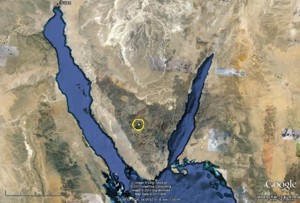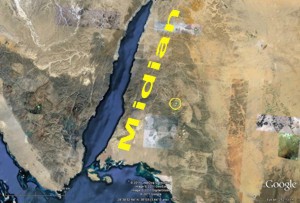|
On the trail of the "mountain of God"
What a stimulating pursuit! I only got into it in earnest a couple of weeks ago (after dabbling with it for many years), but I'm hooked. What am I on about? The route of the Exodus of Israel from Egypt and the location of Mount Sinai. Everybody's into it. One writer, writing in 2000, summed it up well:
The location of Mount Sinai has been receiving a lot of press lately. The Pope just made a visit to the famous mountain in the Sinai peninsula, prompting some journalists to ask if he was traveling to the right place. A few years ago a couple of adventurers visited a mountain in Saudi Arabia, claiming that it was the true Mt. Sinai. Biblical scholars are divided on the question of the location of Mt. Sinai, some favoring the location in the Sinai peninsula and others., favoring the location in Saudi Arabia.1
What strikes you when tackle this popular topic in depth is the lack of logic and sound analysis of data demonstrated by many Exodus enthusiasts. And it's not just the nutters who fall short in these areas; the most erudite and scholarly seem to wear blinkers. Those who favor the traditional identification of Sinai with Jebel Musa in what is now called the Sinai Peninsula seem to be in thrall to tradition; any suggestion of a different mount in a different place is rejected outright, followed by superficial arguments in tradition's defense. Although this author is fully persuaded, along with most of the mavericks, that the famous crossing took place in the Gulf of Aqaba and that Mount Sinai lies somewhere in the Saudi Arabian Peninsula, he recognizes that its proponents, too, indulge in some dubious reasoning. Practically every variant of crooked thinking and illogical reasoning can be found in the literature.
For example, classes on logic and clear thinking all warn against guilt by association. Credit for tagging Nuweiba beach on the eastern side of the Sinai Peninsula as the stepping off point for the Red Sea crossing and Jebel al Lawz in the northwest corner of Saudi Arabia as a possible contender for Mt Sinai goes to the late Ron Wyatt. (He is certainly not the first to suggest a Saudi Arabian home for Sinai. Jewish tradition dating back to the 3rd century B.C. supports the idea.2 But he does seem to be the first to propose the crossing site, and is the modern popularizer of the Saudi Arabian option.) Trouble is that Wyatt has made a number of rather amazing claims and does seem inclined to falsify his evidence.3 Critics of his views jump all over his dubious qualifications and. here comes the guilt by association. Such a person cannot possibly be right about anything, so the true Mount Sinai must be the traditional one. Sorry folks, finding truth doesn't come that way.
Perhaps the chief biblical plank in the argument for a Saudi Arabian location of Sinai can be found in Exodus 3:1-12, where we read that,
Now Moses was tending the flock of Jethro his father-in-law, the priest of Midian. And he led the flock to the back of the desert, and came to Horeb, the mountain of God (vs. 1).
|
Then follows the famous burning bush incident in which God directed Moses to return to Egypt and lead the people of Israel to freedom. At the end of the conversation, God said,
I will certainly be with you. And this shall be a sign to you that I have sent you: When you have brought the people out of Egypt, you shall serve God on this mountain (vs. 12).
Moses had been living in the land of Midian for forty years when this episode occurred. The simplest possible reading of this passage - and the most logical - shows that "this mountain" was in or right next to Midianite territory. Most all scholars agree that the heart of Midianite territory lay on the eastern side of the Gulf of Aqaba in modern Saudi Arabia. This data argues strongly against the traditional site in the south of the Sinai Peninsula. Even if Moses was living in the northernmost part of Midian, the area closest to the traditional site, he would have had to drive his flock 125 or more miles (200 km) to reach it, a fact that comes very close to definitively destroying the traditional site as an option. But supporters of the traditional view don't give in easily. One argues like this:
It is important to note the chronology and context of Ex. 3:1. In Ex. 2:23 the king of Egypt, who wanted to kill Moses 40 years earlier, died. Moses, while tending the flock in Midian for most of the 40 years, heard of his death. A plausible scenario of how he heard about the death was from some frankincense caravan that was returning from Egypt to "South Arabia". The Children of Israel were groaning because of their bondage in Egypt and God remembered His covenant with Abraham, Isaac and Jacob. Moses, who had a concern for his family. and a heart for the children of Israel, wanted to learn more about what was going on. He took Jethro's flock to [the traditional site of] Mt. Sinai. What better cover could Moses want than being an old shepherd tending his sheep? 4
A sensible argument, we ask? No way. Please check a map. The traditional Sinai is about 130 miles (200 km) from the "border" of Egypt and lies in a very rugged area - the last place in creation you would go to to get the gossip on what was going on in Egypt! Moses would have heard a lot more by staying put in Midian and tuning in to frankincense traders' gossip!
One could go on and on with illustrations, especially the circular reasoning that is used to try to identify other locations mentioned in the accounts of the Israelite's wanderings, and so to assist in identifying Mount Sinai. "Since Kadesh Barnea is located at point X, that tells us where Mt. Seir is to be found. And we know where Kadesh Barnea is because it is near Mt Seir." Well, that's a bit of an absurd example, but you get the idea.
The author is in the process of preparing a thoroughly-researched article on this vital topic. Let's hope he is able to practice what he preaches and reason logically and think clearly.
|





